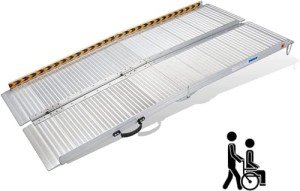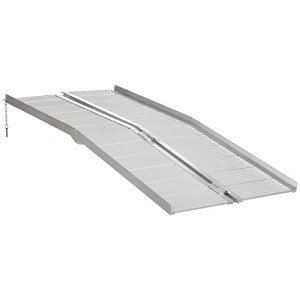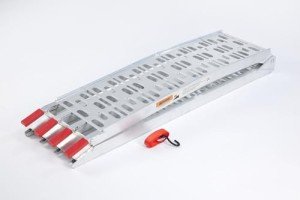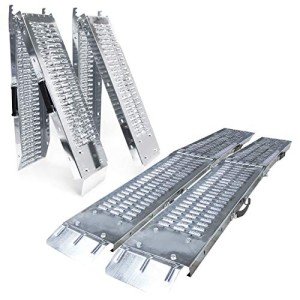In an era where accessibility is becoming a central part of societal consideration, heavy-duty steel ramps have emerged as essential tools for individuals who rely on mobility vehicles. Whether for personal use or community facilities, the right ramp can significantly enhance mobility, ensuring safer and more convenient access to homes, vehicles, and public spaces. This guide provides an in-depth look at heavy-duty steel ramps designed for mobility vehicles, exploring their features, benefits, and notable considerations when selecting the ideal ramp.
Understanding Heavy-Duty Steel Ramps
Heavy-duty steel ramps are robust pathways designed to facilitate the transportation of mobility vehicles, such as wheelchairs and scooters, over uneven surfaces or to elevate them to different heights. They are particularly beneficial in settings where traditional, inclined surfaces are lacking or where the terrain proves challenging.
Key Features of Steel Ramps
-
Material Strength: The primary advantage of heavy-duty steel ramps lies in their durable construction. Steel offers incredible strength and resilience, ensuring that the ramp can support substantial weight and withstand the rigors of daily use.
-
Weight Capacity: Most heavy-duty steel ramps have a weight capacity ranging from 600 to 1,500 pounds or more, making them suitable for a wide variety of mobility devices.
-
Surface Grip: Steel ramps typically feature non-slip surfaces or texturing, enhancing traction and ensuring safety, especially in wet conditions.
-
Portability: Many heavy-duty steel ramps are designed to be portable, featuring foldable designs that allow for easy transport and storage when not in use.
-
Versatility: These ramps can be used in multiple settings, including personal residences, commercial buildings, and outdoor events, catering to varied accessibility needs.
Benefits of Heavy-Duty Steel Ramps
The advantages of using heavy-duty steel ramps for mobility vehicles are manifold:
-
Increased Accessibility: One of the most profound impacts of steel ramps is the enhancement they bring to accessibility. They enable individuals using mobility vehicles to access different levels seamlessly, whether it’s entering a home, accessing public spaces, or entering vehicles.
-
Security and Stability: The robustness of steel construction ensures that users feel secure while navigating the ramp. This stability minimizes the risks of accidents, thereby promoting a sense of independence among users.
-
Long-Term Durability: Steel is resistant to various environmental factors, which makes these ramps suitable for both indoor and outdoor use. Proper maintenance can lead to prolonged lifespans, ensuring users get the most value from their investment.
-
Customizability: Many manufacturers offer customized options, allowing ramps to be tailored to specific needs. This can include adjustments in length, width, and incline, accommodating individual preferences or unique conditions.
Choosing the Right Heavy-Duty Steel Ramp
Selecting the right ramp requires careful consideration of several factors to ensure it meets the user's needs effectively. Below are some crucial aspects to consider:
-
Weight Capacity: Establish the weight of the mobility device plus any additional weight from the user and accessories to determine the necessary weight capacity of the ramp.
-
Ramp Length and Angle: Longer ramps typically feature lower angles, making them easier to navigate for users. A general rule is to allow for one foot of ramp length for every inch of height.
-
Portability vs. Permanence: Decide whether the ramp will be a permanent fixture or if portability is required. This will influence whether a heavier, more durable ramp or a lighter, collapsible ramp is more suitable.
-
Surface Texture: Ensure the ramp has sufficient traction to prevent slipping, particularly in inclement weather.
-
Foldability and Storage: For users requiring frequent transport, a foldable option may be best, while others may prefer a fixed ramp for daily access.
-
Installation Requirements: Some ramps may require professional installation, while others can be easily set up by the user. Understanding installation needs can help avoid complications down the line.
Common Applications
Heavy-duty steel ramps find utility across various environments:
-
Residential Homes: To provide access from the garage to the front door or to navigate steps.
-
Public Facilities: Making community centers, parks, and other public spaces more accessible.
-
Transportation: Assisting individuals in boarding vans, SUVs, and trucks.
-
Healthcare Facilities: Offering patients easy access to examination rooms and treatment areas.
Frequently Asked Questions (FAQs)
1. How do I maintain a heavy-duty steel ramp?
Regular maintenance involves checking for rust, ensuring bolts and screws are tight, and cleaning the surface to maintain grip. After heavy rain or snow, it’s beneficial to clear any debris or ice.
2. Are heavy-duty steel ramps adjustable?
Many models come with adjustable lengths or can be customized during purchase, making it easier to find a suitable incline for specific needs.
3. Can steel ramps be used outdoors without rusting?
Yes, many manufacturers coat their steel ramps with protective finishes to resist weather, but it is advisable to check the product specifications for details on weatherproofing.
4. What is the typical lifespan of a heavy-duty steel ramp?
With proper care and maintenance, a heavy-duty steel ramp can last for several years, often between 5 to 10 years, depending on usage and environmental factors.
5. Where can I purchase heavy-duty steel ramps?
Heavy-duty steel ramps are available through various retailers, including specialized mobility equipment suppliers, home improvement stores, and online marketplaces.
Heavy-duty steel ramps are invaluable tools that provide independence and access for individuals who rely on mobility vehicles. They serve to break down barriers and enhance the quality of life for many, making it imperative for users to carefully consider their options before making a purchase. Whether for home, work, or recreational use, choosing the right ramp can make a significant difference in accessibility and mobility. By understanding the features, benefits, and considerations associated with these ramps, users can make informed decisions that meet their specific needs.






